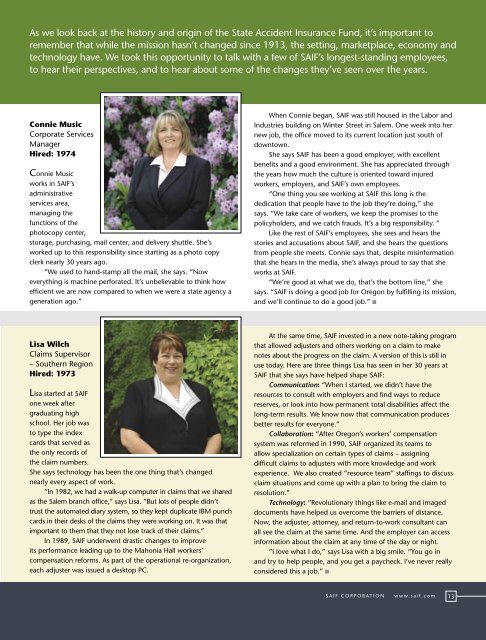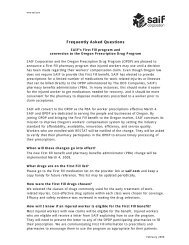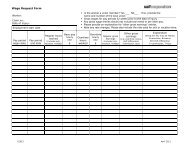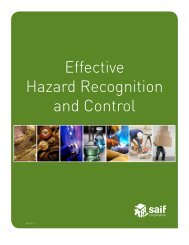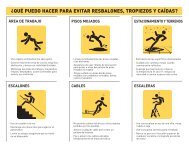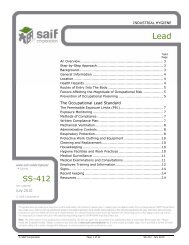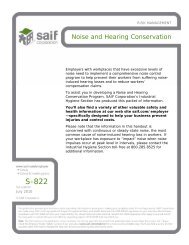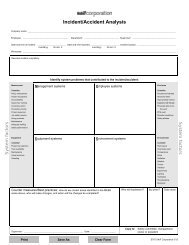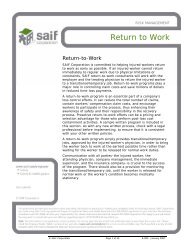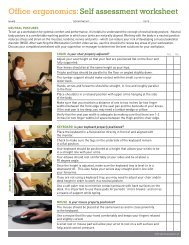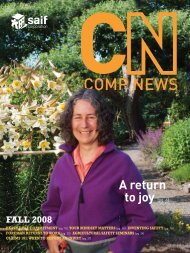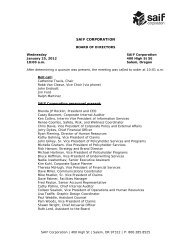Another Alternative - SAIF Corporation
Another Alternative - SAIF Corporation
Another Alternative - SAIF Corporation
- No tags were found...
Create successful ePaper yourself
Turn your PDF publications into a flip-book with our unique Google optimized e-Paper software.
As we look back at the history and origin of the State Accident Insurance Fund, it’s important toremember that while the mission hasn’t changed since 1913, the setting, marketplace, economy andtechnology have. We took this opportunity to talk with a few of <strong>SAIF</strong>’s longest-standing employees,to hear their perspectives, and to hear about some of the changes they’ve seen over the years.Connie MusicCorporate ServicesManagerHired: 1974Connie Musicworks in <strong>SAIF</strong>’sadministrativeservices area,managing thefunctions of thephotocopy center,storage, purchasing, mail center, and delivery shuttle. She’sworked up to this responsibility since starting as a photo copyclerk nearly 30 years ago.“We used to hand-stamp all the mail, she says. “Noweverything is machine perforated. It’s unbelievable to think howefficient we are now compared to when we were a state agency ageneration ago.”When Connie began, <strong>SAIF</strong> was still housed in the Labor andIndustries building on Winter Street in Salem. One week into hernew job, the office moved to its current location just south ofdowntown.She says <strong>SAIF</strong> has been a good employer, with excellentbenefits and a good environment. She has appreciated throughthe years how much the culture is oriented toward injuredworkers, employers, and <strong>SAIF</strong>’s own employees.“One thing you see working at <strong>SAIF</strong> this long is thededication that people have to the job they’re doing,” shesays. “We take care of workers, we keep the promises to thepolicyholders, and we catch frauds. It’s a big responsibility. ”Like the rest of <strong>SAIF</strong>’s employees, she sees and hears thestories and accusations about <strong>SAIF</strong>, and she hears the questionsfrom people she meets. Connie says that, despite misinformationthat she hears in the media, she’s always proud to say that sheworks at <strong>SAIF</strong>.“We’re good at what we do, that’s the bottom line,” shesays. “<strong>SAIF</strong> is doing a good job for Oregon by fulfilling its mission,and we’ll continue to do a good job.”Lisa WilchClaims Supervisor– Southern RegionHired: 1973Lisa started at <strong>SAIF</strong>one week aftergraduating highschool. Her job wasto type the indexcards that served asthe only records ofthe claim numbers.She says technology has been the one thing that’s changednearly every aspect of work.“In 1982, we had a walk-up computer in claims that we sharedas the Salem branch office,” says Lisa. “But lots of people didn’ttrust the automated diary system, so they kept duplicate IBM punchcards in their desks of the claims they were working on. It was thatimportant to them that they not lose track of their claims.”In 1989, <strong>SAIF</strong> underwent drastic changes to improveits performance leading up to the Mahonia Hall workers’compensation reforms. As part of the operational re-organization,each adjuster was issued a desktop PC.At the same time, <strong>SAIF</strong> invested in a new note-taking programthat allowed adjusters and others working on a claim to makenotes about the progress on the claim. A version of this is still inuse today. Here are three things Lisa has seen in her 30 years at<strong>SAIF</strong> that she says have helped shape <strong>SAIF</strong>:Communication: “When I started, we didn’t have theresources to consult with employers and find ways to reducereserves, or look into how permanent total disabilities affect thelong-term results. We know now that communication producesbetter results for everyone.”Collaboration: “After Oregon’s workers’ compensationsystem was reformed in 1990, <strong>SAIF</strong> organized its teams toallow specialization on certain types of claims – assigningdifficult claims to adjusters with more knowledge and workexperience. We also created “resource team” staffings to discussclaim situations and come up with a plan to bring the claim toresolution.”Technology: “Revolutionary things like e-mail and imageddocuments have helped us overcome the barriers of distance.Now, the adjuster, attorney, and return-to-work consultant canall see the claim at the same time. And the employer can accessinformation about the claim at any time of the day or night.“I love what I do,” says Lisa with a big smile. “You go inand try to help people, and you get a paycheck. I’ve never reallyconsidered this a job.”S A I F C O R P O R A T I O Nw w w. s a i f . c o m13


